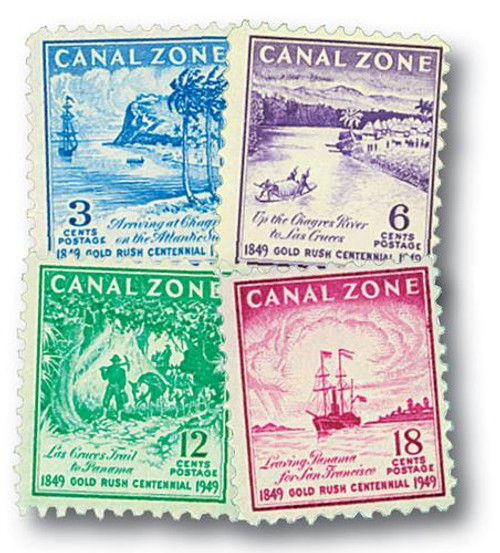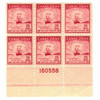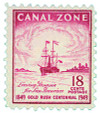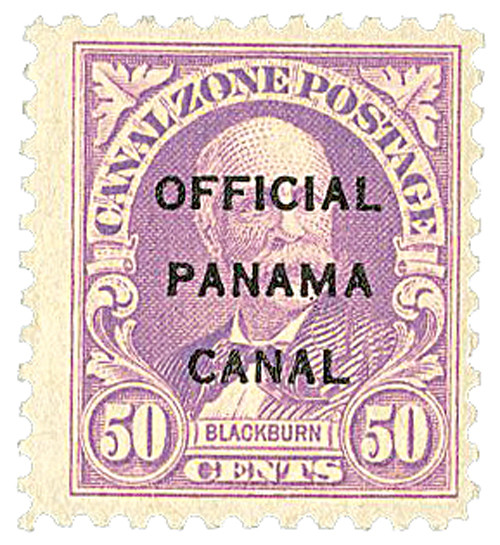
# CZ145 - 1949 18c Canal Zone - Departure for San Francisco, deep red lilac
CZ145 – 1949 18¢ Departure for San Francisco
Gold Rush Centennial
Even before the United States acquired California following the Mexican War, many settlers favored the Isthmus of Panama over the long and dangerous wagon route across the vast plains and rugged mountains. The 1848 discovery of gold in California increased traffic significantly.
A group of New York City financiers organized the Panama Railroad Company. Columbian authorities granted the Panama Railroad Company exclusive rights to construct a crossing across the isthmus. According to the agreement, the crossing could consist of a road, railway, river, or some combination.
After surveying the region, the businessmen chose to build a railroad. The track was completed on January 28, 1855. Its path conveniently mirrored that of the current Panama Canal.
The gold rush travelers restored Panama to prosperity. In the twenty-one year period between 1848 and 1869, approximately 600,000 people crossed the isthmus. Prices for food, supplies, and services were severely inflated, which resulted in enormous profits from meals and lodging.
The gold rush also brought a touch of the Wild West to the isthmus. The 49ers were accustomed to alcohol to relieve boredom, and were frequently armed. Intolerance of other races and cultures led to the “Watermelon War” of 1856, in which at least sixteen people were killed.
A town sprung up on the Atlantic side of the railroad line almost overnight to accommodate the railroad offices, warehouses, docks, and shops. In addition, hotels were quickly built to lodge both railroad workers and travelers. United States visitors named the town “Aspinwall,” after one of the founders of the Panama Railroad Company. Panamanians referred to the town as “Colón,” in honor of Columbus. The names were used simultaneously for many years. However, the Panamanians insisted that no place called “Aspinwall” existed, and therefore, refused to deliver mail addressed to it. The name “Colón” prevailed, and it’s the second largest city in Panama today.
Canal Zone Stamps Chronicle America’s Rise as a World Power
If you’ve never collected Canal Zone stamps before, now’s the time to start. These intriguing stamps are historic links to our nation’s past. With Mystic as your collecting partner, it’s easy to own stamps documenting this remarkable American engineering feat!
With military assistance from the United States, Panama declared its independence from Columbia on November 3, 1903. The Hay-Bunau-Varilla Treaty was negotiated, than ratified in Panama on December 2, 1903. The United States followed suit on February 23, 1904, clearing the way for a long-anticipated canal project across the Panama isthmus.
Almost immediately, administrators began preparations for the tremendous influx of people who would eventually assemble to work on the project. Faced with the knowledge that most of the work force would be imported to the region from America and Caribbean countries, authorities quickly established a postal service to serve their needs as well as those of the Canal Commission.
On June 24, 1904, postal service was established as part of the U.S. Department of Revenue under the supervision of the Treasurer of the Canal Zone, Paymaster E.C. Tobey. On this day, post offices were opened in Ancon, Cristóbal, Gatun, Culebra, and Balboa. Railroad station agents operated as postmasters.
A small supply of 2¢, 5¢, and 10¢ Panama stamps were overprinted “Canal Zone.” Only ordinary mail was handled by the Canal Zone postal system. Mail destined for Central and South America and the West Indies was turned over to the Panama postal service to be forwarded, while mail sent to the United States and its territories and possessions were sent to the U.S. aboard vessels departing for New York.
Overprinted Panama stamps were in use for less than a month. On July 18, 1904, they were replaced by U.S. postage stamps overprinted “Canal Zone.”
In December of 1904, Secretary of War William Taft ordered the overprinted U.S. stamps to be withdrawn, and replaced them with overprinted Panama stamps. Taft’s executive order was reversed in 1924, when overprinted U.S. stamps were placed in use again.
On October 1, 1928, the first permanent issue Canal Zone stamp was issued. The 2¢ stamp featured Lt. Col. George W. Goethal, the Canal project’s chief engineer and first Canal Zone governor.
In 1929, the first Canal Zone Airmail stamp was issued and in 1941, a series of Officials were produced. On October 25, 1978, the last Canal Zone stamp was issued.
CZ145 – 1949 18¢ Departure for San Francisco
Gold Rush Centennial
Even before the United States acquired California following the Mexican War, many settlers favored the Isthmus of Panama over the long and dangerous wagon route across the vast plains and rugged mountains. The 1848 discovery of gold in California increased traffic significantly.
A group of New York City financiers organized the Panama Railroad Company. Columbian authorities granted the Panama Railroad Company exclusive rights to construct a crossing across the isthmus. According to the agreement, the crossing could consist of a road, railway, river, or some combination.
After surveying the region, the businessmen chose to build a railroad. The track was completed on January 28, 1855. Its path conveniently mirrored that of the current Panama Canal.
The gold rush travelers restored Panama to prosperity. In the twenty-one year period between 1848 and 1869, approximately 600,000 people crossed the isthmus. Prices for food, supplies, and services were severely inflated, which resulted in enormous profits from meals and lodging.
The gold rush also brought a touch of the Wild West to the isthmus. The 49ers were accustomed to alcohol to relieve boredom, and were frequently armed. Intolerance of other races and cultures led to the “Watermelon War” of 1856, in which at least sixteen people were killed.
A town sprung up on the Atlantic side of the railroad line almost overnight to accommodate the railroad offices, warehouses, docks, and shops. In addition, hotels were quickly built to lodge both railroad workers and travelers. United States visitors named the town “Aspinwall,” after one of the founders of the Panama Railroad Company. Panamanians referred to the town as “Colón,” in honor of Columbus. The names were used simultaneously for many years. However, the Panamanians insisted that no place called “Aspinwall” existed, and therefore, refused to deliver mail addressed to it. The name “Colón” prevailed, and it’s the second largest city in Panama today.
Canal Zone Stamps Chronicle America’s Rise as a World Power
If you’ve never collected Canal Zone stamps before, now’s the time to start. These intriguing stamps are historic links to our nation’s past. With Mystic as your collecting partner, it’s easy to own stamps documenting this remarkable American engineering feat!
With military assistance from the United States, Panama declared its independence from Columbia on November 3, 1903. The Hay-Bunau-Varilla Treaty was negotiated, than ratified in Panama on December 2, 1903. The United States followed suit on February 23, 1904, clearing the way for a long-anticipated canal project across the Panama isthmus.
Almost immediately, administrators began preparations for the tremendous influx of people who would eventually assemble to work on the project. Faced with the knowledge that most of the work force would be imported to the region from America and Caribbean countries, authorities quickly established a postal service to serve their needs as well as those of the Canal Commission.
On June 24, 1904, postal service was established as part of the U.S. Department of Revenue under the supervision of the Treasurer of the Canal Zone, Paymaster E.C. Tobey. On this day, post offices were opened in Ancon, Cristóbal, Gatun, Culebra, and Balboa. Railroad station agents operated as postmasters.
A small supply of 2¢, 5¢, and 10¢ Panama stamps were overprinted “Canal Zone.” Only ordinary mail was handled by the Canal Zone postal system. Mail destined for Central and South America and the West Indies was turned over to the Panama postal service to be forwarded, while mail sent to the United States and its territories and possessions were sent to the U.S. aboard vessels departing for New York.
Overprinted Panama stamps were in use for less than a month. On July 18, 1904, they were replaced by U.S. postage stamps overprinted “Canal Zone.”
In December of 1904, Secretary of War William Taft ordered the overprinted U.S. stamps to be withdrawn, and replaced them with overprinted Panama stamps. Taft’s executive order was reversed in 1924, when overprinted U.S. stamps were placed in use again.
On October 1, 1928, the first permanent issue Canal Zone stamp was issued. The 2¢ stamp featured Lt. Col. George W. Goethal, the Canal project’s chief engineer and first Canal Zone governor.
In 1929, the first Canal Zone Airmail stamp was issued and in 1941, a series of Officials were produced. On October 25, 1978, the last Canal Zone stamp was issued.













